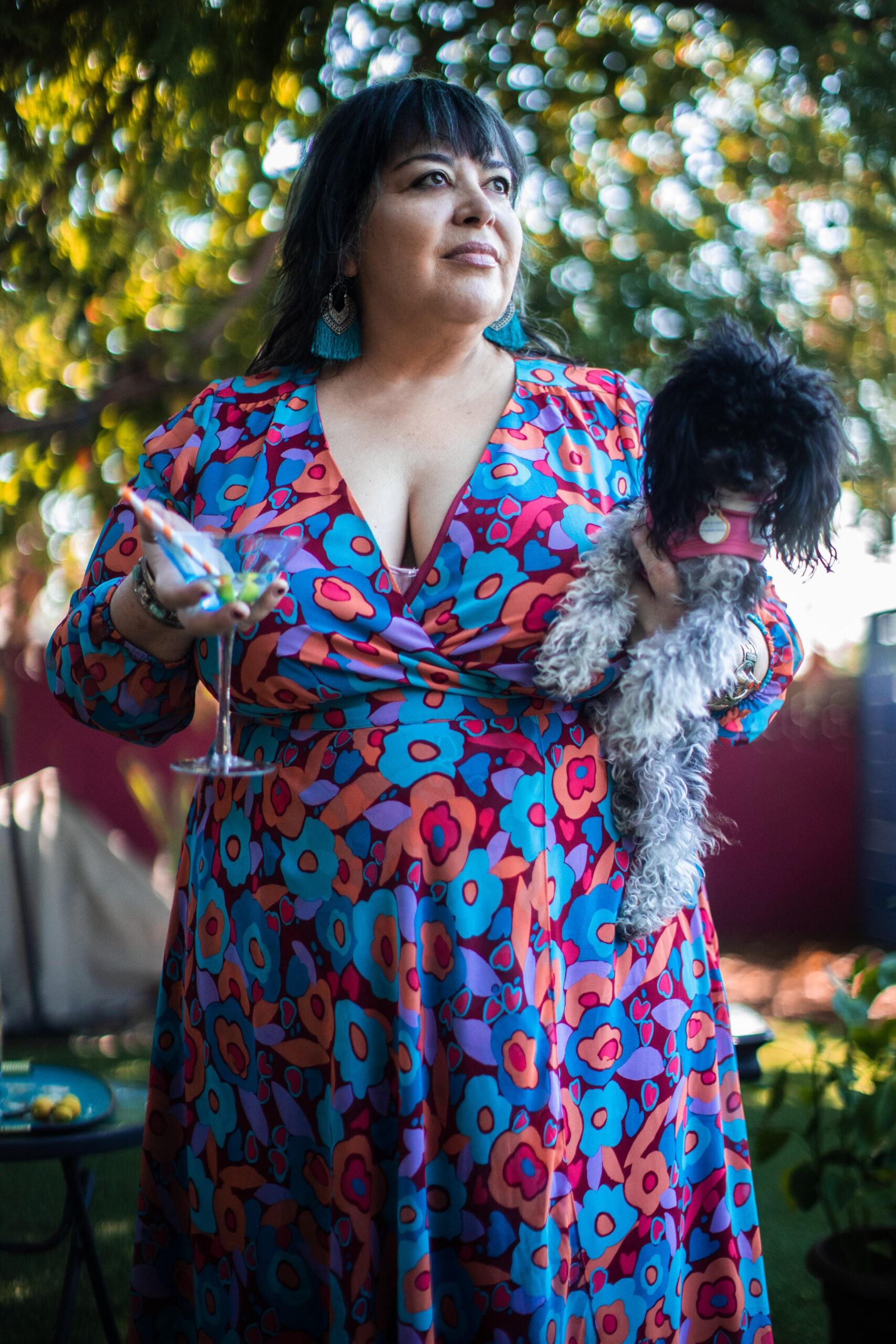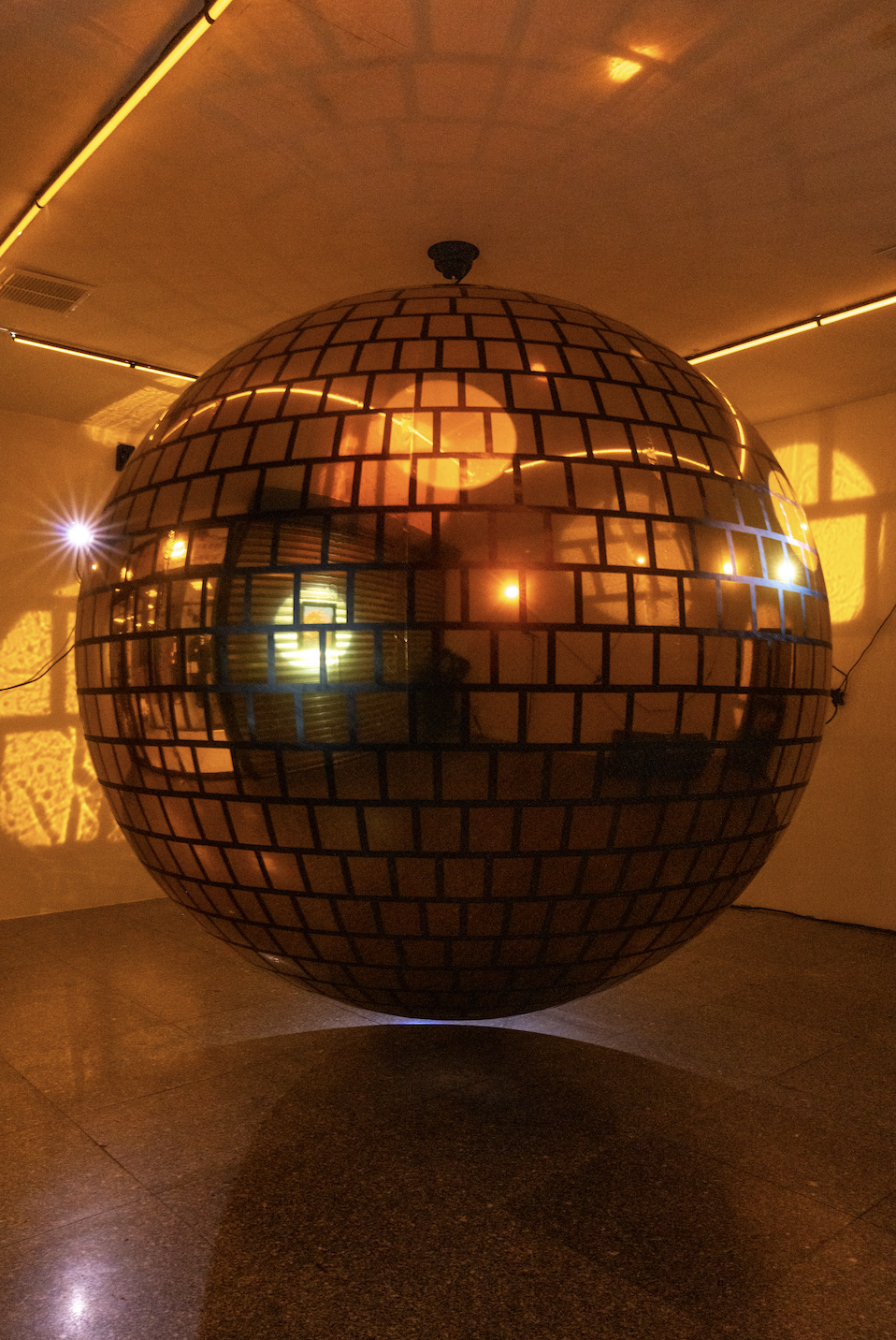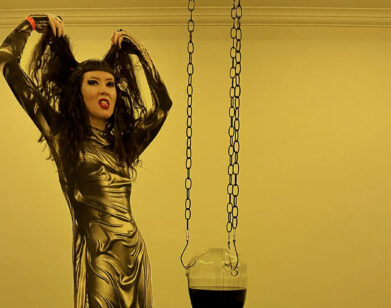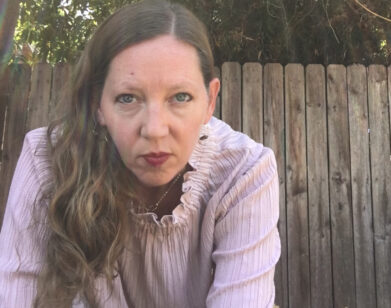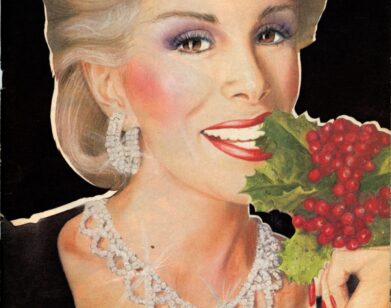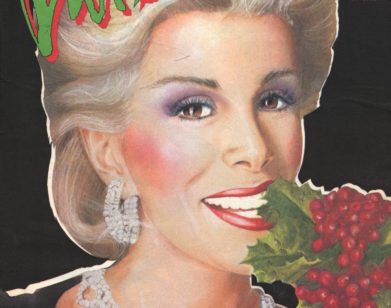IN CONVERSATION
Nao Bustamante and Her Friend Maggie Nelson Go to the Disco
What was my first Nao Bustamante sighting? Was it her face encased in a plastic bag filled with water and taped around her neck (Sans Gravity, 2000)? Was it her wearing a strap-on burrito, inviting white men from the audience to take a bite to absolve themselves of five centuries of Indigenous oppression (Indiggurito, 1992)? Was it as Rosa on a 1992 Joan Rivers show, regaling Rivers with (invented) stories from her life as an exhibitionist (Rosa Does Joan)? Was it in “The Vulnerability Artist,” the beautiful essay about her work written by her friend, the late Jose Esteban Munoz? Notably, I can’t remember—it just feels like Nao’s interventions and experiments have been running like a river beside me, beside us—my entire adult life, offering a steady stream of provocations, innovations, and sustenance.
This past spring I had the good fortune to be in New York in time to see Nao’s most recent work, Brown Disco, installed on the second story of a Chinatown mall [at the gallery OCDChinatown]. Not at all sure we had the right place, I clambered up the steps with my partner Harry—an old friend of Nao’s, from their San Francisco performance days—and located the tiny gallery, which had yet to open for the day. Once the gentleperson with key arrived, we stood for some time listening to a slowed-down karaoke track of “I Feel Love” in the dark while watching a gigantic blow-up disco ball cast honeycomb shadows over the walls. I emerged dazed, and excited to talk to Nao.
Though we share the same employer, live just a few miles apart in Los Angeles, and had seen each other a few nights prior at a party at my house, at which our beloved small dogs got into a scuffle, we jumped on a Zoom together in the ides of June, to talk about her recent installation, midlife retrospecting, evolving audiences and aesthetic strategies, and a motley mess of other things.
———
NAO BUSTAMANTE: Hi, Maggie.
MAGGIE NELSON: How are you?
BUSTAMANTE: I’m good. I’m actually a little bit nervous.
NELSON: Why?
BUSTAMANTE: I don’t know, just the idea of Interview Magazine is a little nerve-wracking to me. For me, it’s a little bit of a cultural post, I guess you could say. So I feel a little nervous about what I’m going to say with Maggie Nelson. I mean, it might be the equivalent of being on the cover of Time Magazine for me.
NELSON: I was curious to hear you talk about how, over time, reality TV and that whole genre has just exploded and it’s different now. As somebody who for so long has been willing and even expert at intervening in those different fields, have your thoughts about the fields changed? Or have your desires to be a part of it ebbed and flowed in relationship to the development of the genre?
BUSTAMANTE: I guess I’ve never really considered myself part of pop culture in a way. I think intervening is a good word. So when I did the Joan Rivers Show, that was a kind of persona. I went on as Rosa, and when I went on the reality show, I did go as myself, but a masked version of myself. I cast myself as the villain, in a way. My strategy there was to try to do things I didn’t know in order to show to the mainstream audience the real confusion that happens when making art. I teach art. So in the teaching process, we try to get our students to explain everything about their process and about what they’re doing. But I know for a fact as an artist that there’s a big mysterious blob in front of you that you’re scraping your way through in order to get at something. But I have to say, when I did do that show [Bravo’s Work of Art], I did pop up into a mainstream consciousness a little bit in a way that was super uncomfortable. There was really a lot of commentary, a lot of trolling focused on my body, my body size. My life is so cool that I get to make art and I get to teach. I really wanted to dive back down into my cultural frameworks that felt comforting after an experience like that. I mean, what about you? You put a lot of yourself out there. I’m wondering how you shield that space.
NELSON: Mm-hmm. It’s interesting, because we’re super different in terms of the art we’ve made and stuff like that, but I’m getting a DNA helix image of momentary shiftings into certain kinds of visibilities. I mean, I wasn’t in San Francisco when you were. But I grew up there and then left. We have some milieu in common. The things I dreamed about were all high demimonde, avant-garde stuff. The dream was to be a part of that. Like you, I’ve felt a lot comfort in the places where I’ve come from, so it always feels like a form of performance or drag to have these other visibility moments. The Argonauts was a really weird thing for me because it was what I considered one of my most niche projects. I mean, I’d written a true crime memoir with Simon & Schuster in 2007. Or The Art of Cruelty, that was with Norton and it was on the cover of The New York Times Book Review. That was not my image of what was going to happen. It was a positive and painful growing period too. I’m sorry, I’m babbling.
BUSTAMANTE: No, I want to know.
NELSON: We kind of came up in a similar ethos where laying bare personal things or your sex life… I mean, it was the age of HIV/AIDS. I was super prude compared to the people that I admired the most. I never felt like I was David Wojnarowicz, or like my particular forms of exposure were very exposed, you know? Eileen Myles had been my teacher and stuff and for Eileen, this radical self-disclosure was the mission. Like you, it’s not as pleasant when you hear back from a culture that doesn’t love or understand where you’re coming from. I mean, I think I’m getting a handle on it. I don’t do social media and I get enough weird emails as it is. I feel like I had to do some forms of shutting down to protect my ability to write in ways that felt alive to me. You don’t want to become less alive because of exposure.
BUSTAMANTE: Yeah, that’s a great kind of ethos. Well, for Brown Disco, I did make a painting, which was kind of—
NELSON: It’s so rad, yeah.
BUSTAMANTE: I sort of found my muse in that brown disco ball. And I’m working on another painting now. What I really am loving about that process is also what I love about performance, which is that I am depending on myself to do it. Because I’ve had such an experience of scaling up my work to the degree where most of the time I’m just getting to know people, hiring people, producing, checking emails. I have a lot of administration to do, so it’s really fun for me just to sit on my front porch and make a little painting.
NELSON: I’m also impressed by your commitment to teaching.
BUSTAMANTE: Well, I’m a very by-any-means-necessary kind of person. So it’s like, “Oh, I need to put this hat on to make this project happen? Okay, I’ll do that.” I’ll struggle my way through. I’ll bluff. I’ll do whatever to make the work, you know?
NELSON: I’m curious about the relationship between idea and manifestation, given how many layers there are. It seems like one would have to be both very patient and very open to the process, how it changes.
BUSTAMANTE: Absolutely. There’s the initial idea, the initial brain burr or the flash. And how that gets pushed back or built out is definitely part of the process. Brown Disco popped into my head pretty much fully realized. And I went at it. I didn’t get to realize it the way that I wanted to. Specifically, I had to find a lot of workarounds.
NELSON: Did you already know it was going to be at OCDChinatown?
BUSTAMANTE: Yeah, when I did the site visit there, that’s what I saw in the space. One, I wanted to do a kind of soft memorial to the different queer-space shootings like Club Q and Pulse nightclub. I just remember feeling so distraught and melancholy. Yes, of course, because of the lives lost, but also because of the infraction into that safe and nurturing space, the space of freedom that can come with a queer nightlife. And it’s been a while since I’ve been hanging out in the clubs and that sort of thing, but I definitely remember that feeling of trying things out and feeling free. That space of facing yourself, but also escapism, was part of the impetus for that work. Did you go with Harry [Dodge]?
NELSON: Yeah, we went. We got there right at the opening, but it wasn’t open yet, so we were waiting. And it was kind of funny, it was like waiting for the club to open. I was mostly just fascinated by the mood of it. This is something else I want to ask you about, which is the relationship between language and discursiveness around the thing. Even though the language around the thing felt like it was making a lot of connections to conviviality, that slowed-down, non-glittery feeling was what was predominant, which I felt like was a deeper and more interesting sense of the Brown Disco.
BUSTAMANTE: Right. Yeah.
NELSON: And the shadows too, because the shadows … Harry kept being like, “These are not glittering. These are architectural.” And it almost felt like there was a panopticon, like honeycomb cells in a way that were not vibing freedom, per se. So I thought there were a lot of complex notes, and I really liked that a lot.
BUSTAMANTE: Yeah. I felt like the slowed-down rhythm was really key. I really wanted to bring people into the rhythm and kind of create a mesmerizing space. And I found when we were installing that, initially, I felt a little nauseous being in the space for so long. But then I did this thing where I walked the speed of the ball with the ball. And I got in this balance with it, I guess, through my body or something. Then I just found joy. I did a lot of dancing in there myself.
NELSON: You did? That’s so great.
BUSTAMANTE: Yeah. I danced a lot in the space, slow motion, soft dancing. My ideal would be that somebody would go in there and use the space to make their own music video. But you’re right, there’s a nod to the club, but it’s not the club. It’s definitely not the club because there’s not enough space for you. The ball is so big that I felt like it was architectural, like Harry says. I wanted to make you feel small, but also make you feel a part of something. I like that you picked up on that, that there were these different levels or notes to the work.
NELSON: How long did it take to install it?
BUSTAMANTE: It was installed over time, meaning that the install was broken up. But it didn’t take too long, probably about a week or so.
NELSON: When you were just talking about having the flash of seeing what you wanted to do with this space when you saw it, I was thinking about this demand for people to explain what they’re doing and why they’re doing it. Cormac McCarthy died and I was reading all these obits. And I was feeling that feeling of light shame that I always feel when there’s some writer out there who’s spent his whole career turning down every lecture, every explanatory talk, every reading. Just kind of saying, “All of that gets in the way of the work. Why would you give any interviews?” I mean, I don’t feel that much shame. I think what I do and what you do, in some ways, sociality is bound with it. I love to talk and I like to talk with other people. Writing is so solitary that I’m grateful that after the solitary part comes the part where we get to talk together. And I was wondering, is the light shame about the flash? There is this thing that you are trying to protect, and you don’t want there to be so much language or discursivity that that becomes where the locus of the activity is. There’s a really funny line that Rachel Harrison once said, that she’s “not sure that language makes art happy.”
BUSTAMANTE: I mean, I love it when people interpret my work, not just by the scholar or the writer but by the viewer. When I was a very young artist, I didn’t really care what people thought. That was a protection in order to make the work. I had to have a bit of a punk rock sensibility in order to put myself out there. But I always have thought about inviting people on the journey with me and I think scholarly interpretation is just one aspect of that. And it’s a very valuable aspect to me, because I think of language as its own art form. Usually, what happens is people theorize their own ideas through the work and they pick work that illustrates their own ideas. So I love the idea of smart people thinking about my work. How great is that? I don’t know that it has affected my production very much.
NELSON: You said jokingly the other night, or not jokingly, “I think this is my retrospective moment.” You’re ready for the taking into account of all the things you’ve done. And I wanted to ask you about that. When people have asked me what having more visibility for my work has been like or done for me, I feel like the best thing in certain ways is that I wrote a lot of books over a long period of time. There was an incoherence, or so my agent tells me, because they were all so different, and now people are more generously reading them all as part of a whole project. So a country might choose to translate everything, even if some of them are criticism, and some of them are lyrical prose, and some of them are books of poetry. But they’re willing to be like, “This is this writer.” And I wonder when you think about a retrospective moment, what you imagine might come into view?
BUSTAMANTE: Yeah. It’s funny because, when I think about my work, I think of it more like a crazy quilt, like a mandala patchwork of different ideas. I see them all feeding in a complex way, connecting these different ideas or different concepts or different modes. I think about my performance work or any of my work as materiality. So as I make an image, whether it be performance, video, sculpture, or otherwise, I think that that image space is a materiality that can be used in another part of my crazy quilt in a way. Or I can recall different aspects. I’ve used roses a lot in my work. I’ve used red a lot in my work. So there’s this way in which I recall different symbology or different ideas to come back in. But in terms of a retrospective, I guess part of it was thinking back to this conversation where I was saying I was going to “come out” about my age, right? I had been lying about my age since I was like 35 or something.
NELSON: I’m dying to hear you talk about this, too.
BUSTAMANTE: I think I was turning 40 in New York. I was having a little party in Brooklyn. It was just below Marga Gomez’s apartment. Jokingly or not, she was saying, “Oh, you really should start lying about your age because this industry is just brutal on older women.”
NELSON: Meaning the art world?
BUSTAMANTE: I think she’s talking generally about art or performance. So as a joke, we got a cake. And I think we very pointedly wrote on it, “Happy 35th,” or something like that. But then more recently I’ve started thinking, “Wow, I’m so old, I need credit. I need that credit before I get any older.” I’ve been doing this other project called Grave Gallery, in which I bought a cemetery plot at Hollywood Forever Cemetery and have been using it and trying to launch a project space there on that three-by-seven plot. For me, the best parts about that project are just doing site visits with people in which I will typically bring two lawn chairs and maybe a thermos with coffee and some pastry. We sit there on the side of my plot and we talk about all the aspects, the fear of death and death and our body and remains and what’s going to happen. “Am I going to really be there? What do I want on the grave?” So there’s been this kind of awakening in me, I guess, to those aspects of mortality. In this way I’m trying to set myself up for the next phase of production, also, which does feel a bit like the space of legacy. And I’m slowing down and wanting to think about concepts or projects that could hold my attention in a broader way. I’ve been thinking about going back into nature more broadly. I’m a big fan of Salmon Creek Farms and works like that, that take us back into the land space. I’m just looking at this life project of art-making and thinking about how I can frame it for the next, I guess, third of my life.
NELSON: Mm-hmm. And you’re going to go to Rome.
BUSTAMANTE: And I’m going to Rome!
NELSON: That’s so cool.
BUSTAMANTE: That’s all part of the slowing-down plan. I was awarded the Philip Guston Rome Prize for 2024. And I’ve been working on this long-term project “Bloom,” which is looking at the history of pelvic examination, so I’m officially going there to look at the early history of women’s health and go visit the first speculum founded in Pompeii from 79 AD.
NELSON: Oh my god. No way. Wow.
BUSTAMANTE: Yeah. I’m a big archive nerd. I’m hoping I’ll be able to get into the Vatican Archive with my status as a Rome Prize winner, we’ll see. But I’m also excited about the who-knows-what aspect of being there. I’ve never been to Italy. It holds such a fascination for me. I’m Mexican, but my last name, Bustamante, there’s a big Italian and Spanish origin there with a different spelling of the last name, M-E-N-T-E instead of M-A-N-T-E. And we had this whole family lore about our European ancestors being Italian and French, and then also having Apache and Yaqui blood. So there are interesting ties into my family lore and I’m excited to go and confront the colonizer in my own ecstatic way.
NELSON: I can’t wait to hear what happens. Is there anything you want to cover that we haven’t talked about?
BUSTAMANTE: Maggie, I want our dogs to try to make a go of it to meet again.
NELSON: Oh, god. My dog is terrible. She’s hard.
BUSTAMANTE: I know, but I think if we introduce them both on leashes outside for a walk…
NELSON: It’s possible. We spent a lot of money during COVID trying to get our dog to get along with other dogs. Eventually, the lady was like, “Your dog just likes people and she doesn’t like other dogs. And nothing’s going to change it.” But it’s possible.
BUSTAMANTE: Has your dog ever liked another dog?
NELSON: She usually tolerates older, very lazy dogs that just are utterly imperturbable, you know? She’ll throw herself at any dog and try to bother them. And if the dog in any way takes the bait, she won’t stop. But if the dog is like, “I don’t know what you’re doing with me, but I’m not going to react,” then she kind of calms down.
BUSTAMANTE: So she doesn’t like younger, hotter, skinnier poodles, is what you’re saying.
NELSON: Your dog is so cute. I hope they can run a picture of your dog in the piece because it’s just unbelievably cute.

